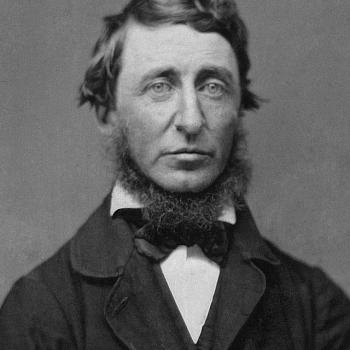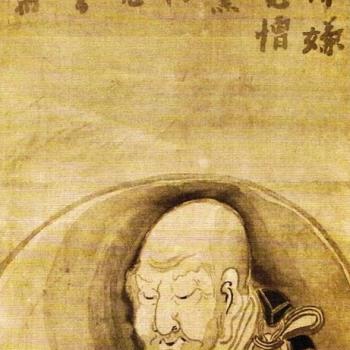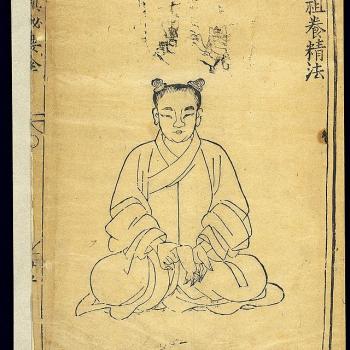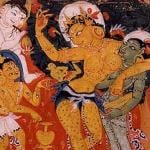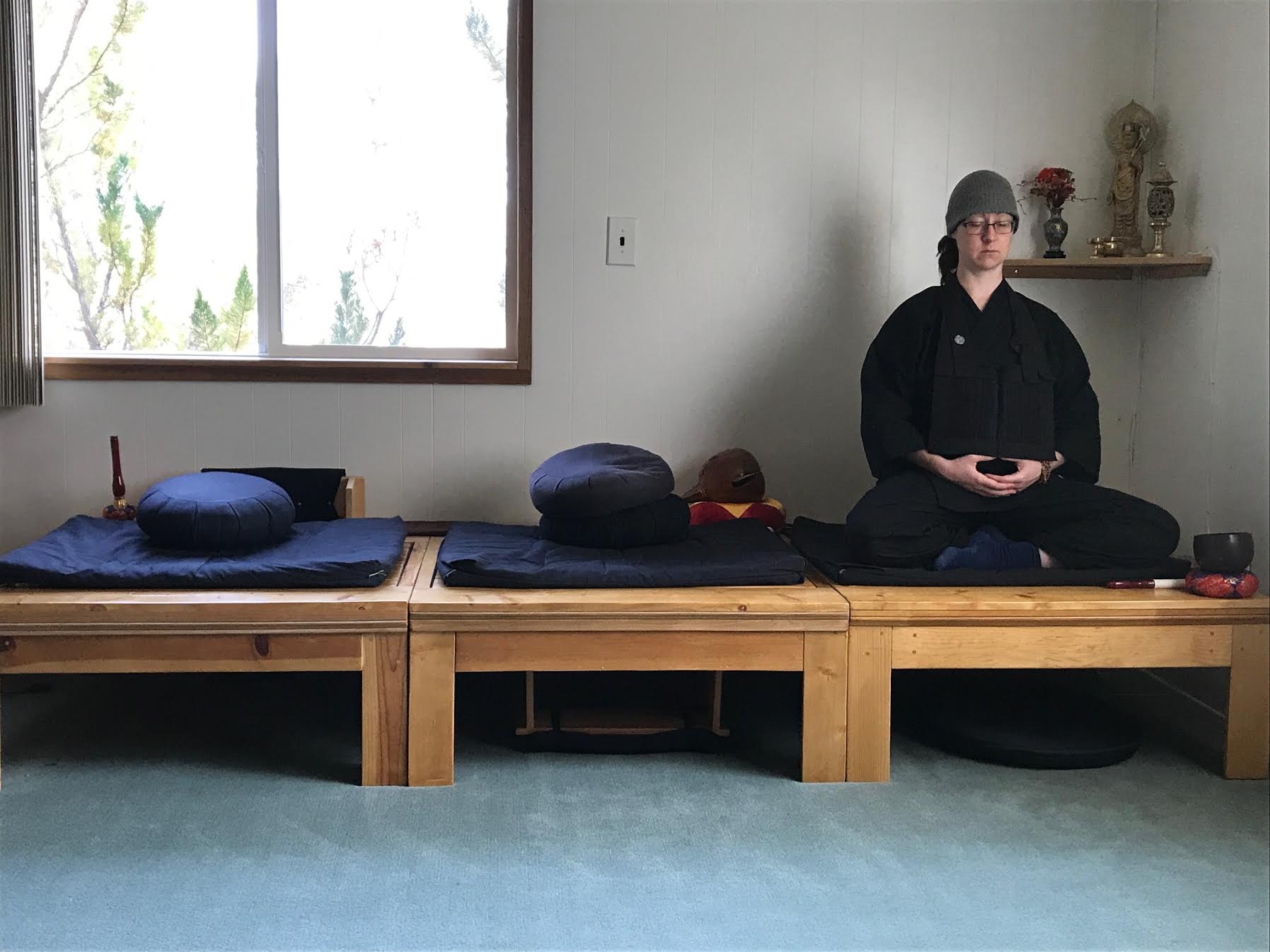
Once again my friend the old Zen hand Ken Ireland wrote a piece over at his Buddha, SJ blog that I thought deserved a bit wider platform. And, once again, he graciously consented to my reprinting it here at Monkey Mind. I hope you enjoy. And, perhaps more importantly, I hope it expands your understanding of Zen meditation.
***
I currently live in Thailand which is a Buddhist monarchy. The king and royal family enjoy the highest rank. Protocol, to my eyes, seems strictly observed despite rumors that the royals are not insistent. An American friend who works at a school in the north was hosting the older sister of King Vajiralongkorn, Princess Ubol Ratana. Only a limited number of people were allowed into the area where she was being entertained, and despite writing and rehearsing the students for a skit in her honor, my friend was not invited.
Rank is exclusionary. It can be palpable and irritating. My friend asked me about the koan “The True Person of No Rank.” My mind went on automatic, and I remembered many times the case had come up during sesshin. Of course, we’d worked with it. Tarrant Roshi had written about it. It appears in both “The Book of Serenity” and “The Record of Linji.” I wanted to make sure that I used an accurate translation, leaving nothing out and including no additions that might distort what Linji Yixuan (Rinzai Gigen in Japanese) taught. I looked up the Case 38, Shôyôroku, with commentary by Yamada Kōun Zenshin Roshi, published by Sanbo Zen International.
Book of Serenity, Case 38
“Rinzai’s True Person of No Rank.”
Instruction:
Taking a robber for your own child, taking a servant for the master:
Could a broken ladle of wood ever be your ancestor’s skull?
The saddle bone for a donkey could never be your father’s jawbone.
When bestowing land with a new branch temple, how would you discern the master?
The Case:
Rinzai instructed his assembly and said, “There is one true person of no rank, always coming out and going in through the gates of your face.1 Beginners who have not yet witnessed that, look! Look!”
Then a monk came out and asked, “What is the one true person of no rank?” Rinzai descended from the rostrum and grabbed him. The monk hesitated. Rinzai pushed him away and said, “The true person of no rank – what a shit-stick you are!”
1 I.e., sense organs such as eyes, nose, ears, tongue, etc.
_____________
In the big picture, I am no different than any other human. If King Charles or King Vajiralongkorn and I sat on cushions in my imaginary zendo, we would all receive the same data coming out and going in from our sense organs. We’d remain equal without rank even after their royal coaches whisked them home. I expected Yamada would point to the one true person with perhaps a few hints about the shit stick.
How wrong I was. Yamada’s commentary was a long, detailed description of a “kensho zendo;” he focused on a strict level of attention or concentration he felt was required for experiencing this sudden enlightenment; I heard echoes of the contentious talk about the possibility of kensho (which is Japanese for “seeing into one’s nature”) between the Soto and Rinzai Zen schools. I was shocked.
It was also dull. I was not particularly interested in students adjusting the blinds in Zendo. For Yamada, it indicated that they were allowing their minds to stray from the single-pointed attention required to experience “kensho.” There was a long and involved story about a fellow named Kasan Roshi who threatened to throw some monks out of his temple for performing a commendable act of compassion while doing “takuhatsu” (托鉢), or alms-begging.
How on earth did I jump from sitting on an equal footing with King Vajiralongkorn to listening to Yamada’s fussing over whether the zendo’s blinds were rolled down during seated meditation, or Kasan expelling monks who’d proven themselves unsuitable because they allowed themselves to be distracted?
Kensho!
Then, the random nature of my laptop’s search tossed up a frothy piece by Brad Warner. He takes issue with Melvin McLeod, the editor of “Best Buddhist Writing of 2004,” in which Brad was included. McLeod thought that Brad was describing a kensho experience. Brad chides himself for not being clear enough: “I have never had a kensho experience. I hope I never do. I’ve never come across anyone who claimed to have had one of those who could convince me it was anything worth experiencing.”
Yamada’s position was very different from Brad’s or Dogen’s, the Japanese founder of the Soto sect that Brad follows. Yamada quotes Hakuin Ekaku, the Japanese reformer of the Rinzai sect: “Anyone who would call himself a member of the Zen family must first achieve kensho—realization of the Buddha’s way. If a person who has not achieved kensho says he is a follower of Zen, he is an outrageous fraud—a swindler pure and simple.”
After reading Brad very carefully, even if briefly, because he says pretty much the same thing over and over, I wondered if Dogen ever talked about a kensho experience in a way either Dogen or Brad, and Yamada or Haquin might be able to speak to one another about meditation experiences rather than shouting at one another to make a point.
I stumbled across something that Dogen said before he left China. Keizan Jokin Zenji, his dharma heir, writes that he did have an experience, an opening, that confirmed what he had learned from Rujing with whom he completed his training. (See “The True Dharma Eye,” Tanahashi (2011), p. 144). The quote suggested that Dogen did have something akin to a kensho experience despite all the howling to the contrary. Like the fool who thinks that he’ll remember everything necessary or startling, I did not make a note of either the quote or the source so I can’t include a useful footnote.
To be fair to Dogen and Brad, emphasizing kensho might be dangerous or misleading. The Rinzai Teachers’ Bureau has supplied no map. Loose talk might create some overblown expectations. Brad says his teacher, Gudo Wafu Nishijima, sometimes talked about “solving philosophical problems” when experiences in Zazen were out of the ordinary. He claims that all states of mind that arise in Zazen are equal level thought formations, solved with simple Zen application if you’re lucky. “He calls it this because that’s all it is.” It’s not required. We’re not too far from shouting at one another.
In spring 1978, Michel Foucault met and practiced with Omori Sogen Roshi. One of the most important Zen masters of the last century met a brilliant philosopher whose work explored the way discourse shapes our reality. Their work together lasted less than three weeks, and Foucault died only five years later. Had his life not been tragically cut short, what contribution might Foucault have added to our understanding of Zazen? We’d be fools if we didn’t recognize that the way we speak about meditation, the shape of our discourse, colors our experience.
I practice in the dharma stream of Yamada Kōun and his teacher, Yasutani Haku’un Ryoko. Although I enjoy and find value in Brad’s non-doctrinal style, I intend to bolster Yamada’s case for practicing in a Kensho Zendo. I’m going to speak from my own experience, and rather than take a side, I’ll just focus on what is important to me, the conversations I’ve had about these experiences with my teachers. Please don’t take my descriptions as normative in any way. What matters is your own experience.
_____________
Body, Mind and Breath
My body has a mind of its own.
I had the good luck to learn to sit Zazen in a Soto Zendo. I had practiced seated meditation before, but these experiences were limited to the weave and sway Siddha yoga halls or the more relaxed Vipassana practice, which has been adapted for Westerners..
When I first sat Zazen for a long day at Hartford Street, my body hurt by noon. By 5 PM, I could barely stand. When I sat my first three-day sesshin, I limped home. People gave varying lengths of time for the pain to disappear, though this was usually coupled with a light-hearted statement that enlightenment was a sore back and stiff knees. I was encouraged to persist. Somehow I did.
That period coincided with Issan’s final years. His body could not muster the same kind of determination as in his early training, but he still sat totally erect. I noticed when he slumped and seemed to drift off, but it was not often. Of course, just noticing that was an indication that I was being less than attentive to my state of mind.
After 80 years, my bones have shortened; the intervertebral discs’ thickness and resilience show signs of wear and tear. I have to sit in a chair, usually with a small curved brace near the base of my spine, but my body automatically assumes a comfortably erect posture, the vertebrae neatly stacked on top of one another, holding my head erect with my jaw relaxed. If I discover anything carelessly out of place, a few simple self-commands plus some relaxation allow me to focus much longer than I could 35 years ago. I hesitate to describe another sensation that occurs almost automatically, other than to say I tap into an energy that has a mind of its own and, if I allow it, takes over. Of course, the tendency to fall asleep or lose concentration has not magically vanished.
Lesson One: An alert body is the primary tool for an alert mind.
_____________
Issan used to say, “Don’t invite your thoughts to tea.”
I can’t stop my mind, but cessation of mental activity is not the end of practice. Actually, cessation is inevitable. It’s called death and will come soon enough. In the meantime, if you can’t stop thoughts from showing up, and you can’t ignore them even though it might run counter to normal, polite or accepted behavior, you can at least observe them and watch the habitual way that your mind responds.
When asked what to do about pesky thoughts, Suzuki Roshi advised giving your cow a more extensive pasture. He was Japanese, so social distance from domestic animals was understood differently, even in post-Hippie California. In rural Japan, the cows might be living in the dining room.
I grew up in rural Connecticut. Painted in crude letters on the side of the cow barn at Parker’s Dairy was the slogan: “Parker’s Cows are Parker’s own. Come and see them in their home.” As kids, we visited and quickly figured out that the sign was pure advertising and that we weren’t always welcome in the cow barn, particularly during feeding or milking. So we figured out how to leave the North Street gate ajar and then laugh when Parker and all the cowherds ran up and down Huntington Turnpike, rounding up 20 cows who had stepped beyond the barbed wire. That’s not what Suzuki Roshi had in mind when he counseled increasing the size of their pasture.
Issan’s advice was couched in coffee house etiquette; cows didn’t roam the Castro. But the kernel remains the same: do not engage thoughts that seem to intrude, especially at quiet moments. Simple observation changes the phenomenon.
Lesson Two: It is possible to quiet your mind.
_____________
Count to zero
Over the years, I’ve tried a wide variety of recommended breath-counting exercises: from one to ten, repeat or go forwards and backwards; the inhalation and exhalation counting as one breath or counting as two; 1 to 10, 9 to 2; 3 to 8, and so forth; the seemingly impossible regulation—in through the right nostril and out through the left (or was it vice versa?). I have spent hours focusing on the diaphragm, calling it the dantian (“elixir field” or “sea of qi”), to increase my lung capacity. I was told by a Master of Qigong that getting the asshole involved by conscious contraction helped boost the energy at the base of spine, so I spent months—you guessed it. I asked many teachers and got lots of conflicting advice, akin to the conflicting conversations they were intended to conquer.
Aitken Roshi talked about “the impossibility of counting to ten.” He said that he has found the breath counting practice useful both when he began and later when his practice matured. It’s simple and cuts through. There is a point where even barely intelligible numbers following the breath also fade out, and all that remains is the breath. I am not claiming that this is an ideal state of meditation, but it seems to be an opening into that place where both body and mind could drop away. I call it counting to zero, but if you experience it, you can name it anything you like.
Lesson Three: The breath is connected to everything. Pay attention.
_____________
Sit like a rock; it is the pearl beyond price. But don’t charge money for the experience.
I’ve been having conversations with people from the relatively new discipline of “personal coaching.” They usually group bits and pieces of meditation practice into a workshop format they call Mindfulness. They contend that these disciplines calm the haphazard functioning of the mind, but, given the elemental neurological composition of the brain, every technique I’ve talked about, the yogic position on the body, the calming of wayward thoughts and disturbing emotions, the training of attention by following the breath, are just that. They each have a specific goal: to become more productive, make more money, sleep better, or even experience more satisfying sex. Add these to the list of possible outcomes, and attach a price list.
Though these outcomes are possible, I fear life coaches sell meditation short if they stop there. These coach practitioners can be a bloodless, analytical lot. There is a reason why never charging for teaching has endured for more than two millennia.
Practice can open a path to the center of everything. The Koan collection is packed with story after story about practice becoming stale and comforting but not open to much new. Repeated exercises become rote. Meditation halls are filled with advice about keeping it fresh. In some cases, with some teachers, sitting like a rock can even become a fetish, and, at least in my experience, even a spiritual fetish is not something we should aspire to achieve.
In one of his short online talks, Richard Baker Roshi says that an essential but often overlooked quality of zazen is akin to affection or love. For meditation to settle in and become part of our lives, we treat it like a lover, a constantly changing relationship that we can’t give up on or put down. It’s not an easy path. We will surely have fights and rocky periods, but the rewards are immeasurable.
I have fallen in and out of love, and I have years of therapy to help me sort the wheat from the chaff. And I keep coming back to Zazen.
Lesson Four: Allow yourself to fall in love with Zazen.





